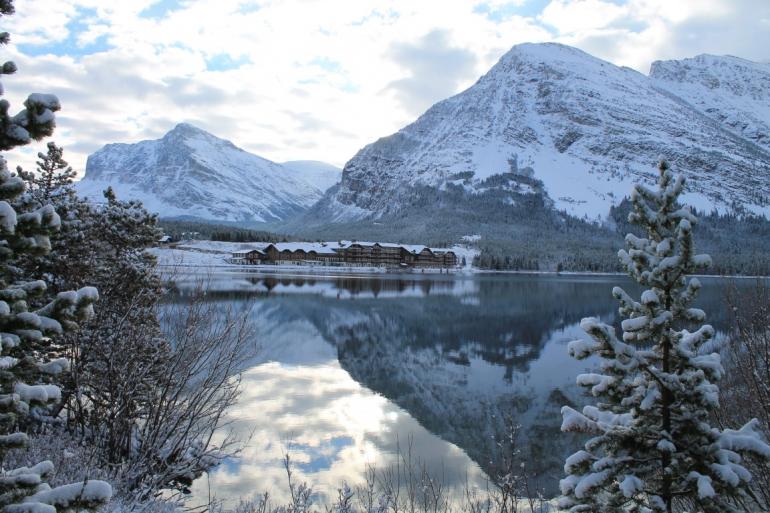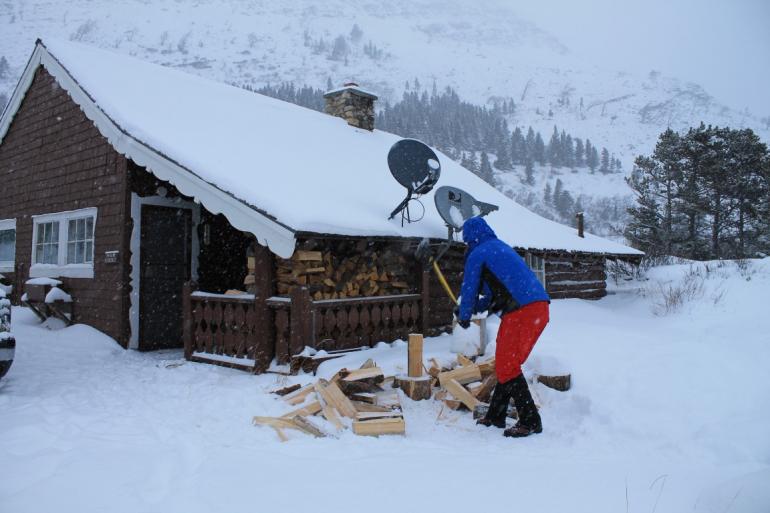Alone at Many Glacier: Being a Winterkeeper at One of Montana’s Least Accessible Hotels

It sounds like a social media meme: Could you stay at Many Glacier for five months—in the winter—without ever going into town?
For David and Rebecca Wilson, their answer was “yes” times four.
Every summer, millions of visitors flock to the jaw-dropping beauty of the Many Glacier Valley in Glacier National Park. Trails resemble lines of ants heading to the glorious lakes, glaciers, and peaks of the region, and parking is a competitive sport. But when the road closes, often due to snow, few ski, bike, or hike the seven miles to the hotel, leaving the area in quiet solitude to the wildlife and the winterkeepers.
With David already working on the maintenance crew in Many Glacier during the 2014 season, when the winter caretaker position for the Many Glacier Hotel and surrounding buildings opened up , it sounded particularly intriguing. Both game for a new adventure, David and Rebecca decided to jump at the opportunity. Suddenly, they needed to prepare for five months of isolation, living the quarantine lifestyle long before it was cool.
It’s practically impossible to mention a winterkeeper’s position without thinking of The Shining, but aside from the wind sounding like people singing down the halls of the grand old hotel, David assures us it is far more grounded. Barely skipping a beat from his summer work, he had plenty to accomplish when the guests were gone. As with any senior structure, there are always features to fix and improve, and given the remote location, the Wilsons were constantly watchful for the effects of water, ice, or snow.
Beyond caring for a century-old hotel hours from any civilization, it was like any other day at work.
“I worked a regular week. I created a lot of my own work list. I knew what I need to do before the spring,” he said.

Making themselves at home
Preparing to hunker down for months required more than stocking up on toilet paper. Planning their food options was one of the most intensive projects, and it was often up to Rebecca to pull together the supplies as David finished buttoning up the hotel and property for the winter. This required multiple trips to Kalispell, a three-hour drive away, to fill the three freezers and gather everything they needed before winter closed their access to the outside world.
“In the beginning we made a few mistakes,” he said. “We were eating meat and flour-based food for a long time.” They also ran out of frozen vegetables, which might not seem like a big deal until a big bowl of broccoli is a delicacy. David commented that by the time they were able to head to town in the spring he went from a dedicated carnivore to a hardcore vegetarian for a couple of weeks.
“We kind of had it down to a science by the end,” David said.
Protecting food from animals has always been an issue for those living in remote areas. Many early pioneers stored what they needed in tall caches to prevent bears from reaching it. For the Wilsons, their nemesis was mice.
“One mouse could destroy a third of your winter food,” he said, but with a couple of effective cats and well-sealed totes, they kept their rice, lentils, flour, sugar, and other dry goods safe.

Harsh lesson
Daily life developed a type of rhythm, yet David experienced a jarring wake-up call at work during their first season. One day while he was working in the shop, completely wrapped up in his project, he lost track of time. When he finally looked outside, it was dark.
The walk from the shop to the chalet is only a few hundred yards; it’s an absolutely lovely stroll during the summertime. But in the winter, it’s surreal. Howling wind and utter blackness make finding the path daunting. David said he focused on the light of the chalet to navigate around the nine-foot-high snowdrifts as best as he could.
Despite walking this route hundreds of times, he said, “I veered off. I had a good lantern, but I walked out onto the lake a little bit.”
The lake was frozen, but he unknowingly ventured onto soft ice near the waterfall, falling through to his knees. Fortunately, he quickly extricated himself and scrambled to solid ground.
“It was a terrible, terrible mistake. It could have cost me my life,” he said. “I was terrified.”
It proved a valuable learning experience: A misstep in these circumstances can spell death.

Living their best life
Although David had a lengthy list of projects keeping him busy, he and Rebecca took advantage of the extraordinary opportunity to have the area to themselves when the weather cooperated.
On relatively calm days, they grabbed their skis or snowboards to see the area as others rarely experience. David said early in the season, before the snow was too deep, they hiked to Grinnell Glacier, yet as the snow increased, they limited their range. David said they tried to stay out in the open. “You don’t get too close to the mountains because of avalanche danger.”
Once the lakes were frozen, they often skied across Josephine Lake, around Swiftcurrent Lake, or even climbed up the open slope of Mount Atlyn for a unique perspective on their wintertime home.
The Wilsons also enjoyed the entertaining company of the local wildlife. The bighorn sheep were fairly consistent residents wandering the parking area and along the cliffs, or curiously peeking into their windows. During one instance, David was grateful that a ram looking into their window didn’t see his reflection, or he would have added replacing the glass to his worklist.
As anyone familiar with Many Glacier knows, this is the place to see bears. David and Rebecca recognized several familiar locals, and always kept their eyes open when they were working or playing in the area as the weather warmed in the spring. During their first year, Rebecca took a photo from the safety of their porch as the grizzly strolled right along the road in front of her. Even so, David said, “They tend to mind their own business.”
Spending five months together in this remote, harsh environment is as much of a mental challenge as anything physical, but the Wilsons returned year after year as an indelible chapter of Glacier’s history. Every season the story was different. Their first winter, 2014-2015, was a relative breeze with mild weather and a low snowpack. It was a deceptive welcome. Yet, as one never knows what to expect, the final winter of 2017-2018 was one for the books with relentless storms and record-breaking snow. Thankfully, it was something these now winter veterans could handle.
Currently embarking upon new adventures with their growing family, specifically their one-year-old son, Davey, David looks back with fondness as their time as caretakers.
“There’s a lot I miss,” he said.
But the reality is, they are as much a part of the Many Glacier story as Many Glacier is of theirs, and when they return, it will feel like coming home.
In 2019, David and Rebecca published their full-color book, Winter at Many Glacier: A View from the Edge, to give readers a glimpse into their lives as winter caretakers. This is a world few of us are privileged to see, which is why the Wilsons’ book gives a brand new sense of appreciation for this stunningly beautiful, yet equally harsh, region we love.
Look for their book on Amazon. It can also be ordered via their Facebook page, MGH Caretaker Photos, at https://www.facebook.com/manyglacierwinter/, or email David at [email protected].




